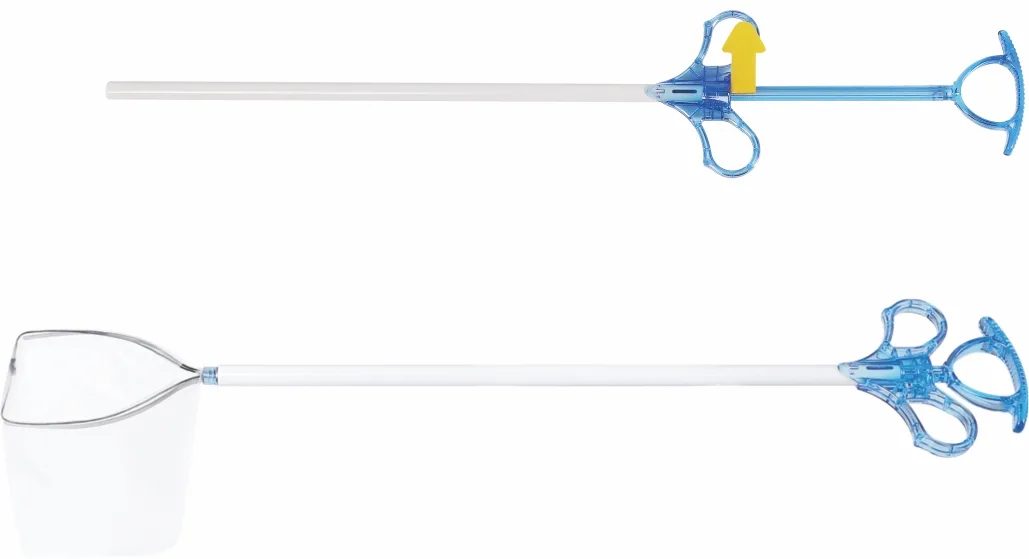- Home
- All Products
- Laparoscopic Instruments
- Disposable Specimen Retrieval Bag
Disposable Specimen Retrieval Bag
Disposable Specimen Retrieval Bag
A disposable specimen retrieval bag, also known as an endoscopic specimen bag or endo bag, is a medical device used to safely remove tissue specimens, organs, or other materials from the body during minimally invasive surgeries. These bags are particularly useful in laparoscopic and robotic-assisted procedures where small incisions are used, and the retrieval of specimens needs to be managed carefully to prevent contamination and ensure complete removal.
Available as
Handle A (1st Image)
10mm Introducer. 250ml Volume
10mm Introducer. 350ml Volume
10mm Introducer. 1000ml Volume
Handle B (2nd Image)
10mm Introducer. 250ml Volume
10mm Introducer. 350ml Volume
10mm Introducer. 1000ml Volume
10mm Introducer. 1200ml Volume
12mm Introducer. 1500ml Volume
Components and Design
- Bag: A sterile, flexible pouch made of durable, biocompatible material (often polyurethane or polyethylene) designed to hold and contain the specimen.
- Opening Mechanism: The bag often includes a rigid or semi-rigid rim or mouth to keep the bag open when deployed within the body cavity.
- Deployment System: The bag is typically deployed through a trocar or port and is often folded or rolled within an introducer device.
- Drawstring or Closure Mechanism: Ensures the bag can be securely closed once the specimen is inside to prevent spillage and contamination.
Uses
- Laparoscopic Cholecystectomy: Removal of the gallbladder.
- Appendectomy: Removal of the appendix.
- Myomectomy: Removal of fibroids from the uterus.
- Ovarian Cystectomy: Removal of ovarian cysts.
- Nephrectomy: Removal of kidney tissue or whole kidney.
- Oncological Surgeries: Removal of tumor specimens for diagnostic and therapeutic purposes.
Advantages
- Sterility: Being disposable, each bag is sterile-packed, ensuring no risk of cross-contamination.
- Convenience: Eliminates the need for cleaning and sterilization, saving time and reducing turnaround times between surgeries.
- Safety: Minimizes the risk of spillage and contamination within the body cavity during specimen retrieval.
- Integrity: Ensures the complete retrieval of specimens, including small fragments that might otherwise be left behind.
- Ease of Use: Designed for easy deployment and retrieval through small incisions, making them suitable for minimally invasive procedures.
Procedure
- Preparation: The surgical area is prepped, and the patient is positioned appropriately.
- Deployment: The folded specimen retrieval bag is inserted into the body cavity through a trocar or port.
- Opening: The bag is opened within the body cavity, often using a drawstring or rigid rim to maintain its shape.
- Specimen Placement: The tissue specimen is placed into the open bag using laparoscopic instruments.
- Closure: The drawstring or closure mechanism is used to securely close the bag, containing the specimen.
- Extraction: The closed bag is carefully withdrawn through the trocar or port, ensuring no spillage occurs.
- Completion: The bag is removed from the surgical site, and any necessary steps are taken to conclude the procedure.
Types and Variations
- Manual vs. Automated Deployment: Some bags require manual deployment and opening, while others feature automated systems for ease of use.
- Different Sizes: Available in various sizes to accommodate different types and sizes of specimens.
- Reinforced Bags: Some bags have reinforced edges or are made from stronger materials to handle larger or heavier specimens.
Examples of Procedures Using Disposable Specimen Retrieval Bags
- Laparoscopic Hysterectomy: Removing the uterus or parts of it.
- Laparoscopic Nephrectomy: Removing part or all of a kidney.
- Laparoscopic Splenectomy: Removal of the spleen.
- Laparoscopic Colorectal Surgery: Removal of segments of the colon or rectum.
- Robotic-assisted Surgeries: Various procedures utilizing robotic systems for precision.
Clinical Considerations
- Size Selection: Choosing the appropriate size of the bag based on the specimen size to ensure proper containment and retrieval.
- Deployment Technique: Ensuring proper technique to avoid accidental spillage or incomplete retrieval of the specimen.
- Patient Safety: Maintaining sterility and minimizing the risk of infection or contamination during the procedure.
Disposable specimen retrieval bags are essential tools in minimally invasive surgery, providing a reliable, sterile, and efficient means of removing tissue specimens. They enhance the safety and effectiveness of laparoscopic and robotic-assisted procedures, contributing to better patient outcomes.










